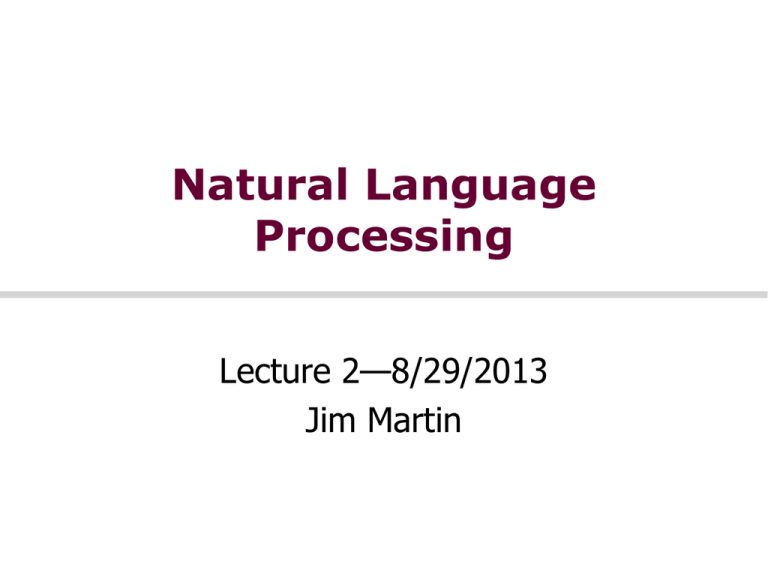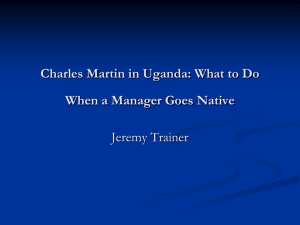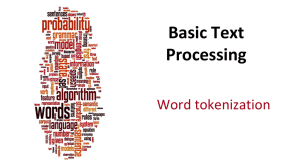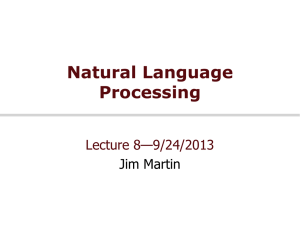lecture_02
advertisement

Natural Language Processing Lecture 2—8/29/2013 Jim Martin Today • Review/Finish last time • Finite-state methods 4/13/2015 Speech and Language Processing - Jurafsky and Martin 2 Categories of Knowledge • • • • • • Phonology Morphology Syntax Semantics Pragmatics Discourse Morphological Processing 4/13/2015 Each kind of knowledge has associated with it an encapsulated set of processes that make use of it. Interfaces are defined that allow the various levels to communicate. This often leads to a pipeline architecture. Syntactic Analysis Semantic Interpretation Speech and Language Processing - Jurafsky and Martin Context 3 Ambiguity • Ambiguity is a fundamental problem of computational linguistics • Resolving ambiguity is a crucial goal 4/13/2015 Speech and Language Processing - Jurafsky and Martin 4 Ambiguity • Find at least 5 meanings of this sentence: I made her duck 4/13/2015 Speech and Language Processing - Jurafsky and Martin 5 Ambiguity • Find at least 5 meanings of this sentence: I made her duck • • • • • I cooked waterfowl for her benefit (to eat) I cooked waterfowl belonging to her I created the (ceramic?) duck she owns I caused her to quickly lower her upper body I waved my magic wand and turned her into undifferentiated waterfowl 4/13/2015 Speech and Language Processing - Jurafsky and Martin 6 Sources of Ambiguity • I caused her to quickly lower her head or body. Lexical category (part of speech): “duck” can be a noun or verb; a verb in this case • I cooked waterfowl belonging to her. Lexical category: “her” can be a possessive (“of her”) or dative (“for her”) pronoun • I made the (ceramic) duck statue she owns Lexical Semantics: “make” can mean “create” or “cook”, and about 100 other things as well 4/13/2015 Speech and Language Processing - Jurafsky and Martin 7 Ambiguity is Pervasive • Syntax: Make can be: Transitive: (verb has a noun direct object) I cooked [waterfowl belonging to her] Ditransitive: (verb has 2 noun objects) I made [her] (into) [undifferentiated waterfowl] Action (di) transitive (verb has a direct object and another verb) I caused [her] [to move her body] 4/13/2015 Speech and Language Processing - Jurafsky and Martin 8 Problem • Remember our pipeline... Morphological Processing 4/13/2015 Syntactic Analysis Semantic Interpretation Speech and Language Processing - Jurafsky and Martin Context 9 Problem Morphological Processing 4/13/2015 Semantic Semantic Semantic Interpretation Semantic Interpretation Semantic Interpretation Semantic Interpretation Syntactic Semantic Interpretation Syntactic Semantic Interpretation Syntactic Analysis Semantic Interpretation Syntactic Analysis Semantic Interpretation Syntactic Analysis Semantic Interpretation Syntactic Analysis Semantic Interpretation Syntactic Analysis Semantic Interpretation Analysis Semantic Interpretation Analysis Semantic Interpretation Semantic Interpretation Semantic Interpretation Semantic Interpretation Interpretation Interpretation Speech and Language Processing - Jurafsky and Martin 10 Algorithms • Many of the algorithms that we’ll study will turn out to be transducers; algorithms that take one kind of structure as input and output another. • Unfortunately, ambiguity makes this process difficult. This leads us to employ algorithms of various sorts that are designed to manage ambiguity 4/13/2015 Speech and Language Processing - Jurafsky and Martin 11 Paradigms • In particular.. State-space search To manage the problem of making choices during processing when we lack the information needed to make the right choice Dynamic programming To avoid having to redo work during the course of a state-space search • CKY, Earley, Minimum Edit Distance, Viterbi, Baum-Welch Classifiers Machine learning based classifiers that are trained to make decisions based on features extracted from the local context • Used to decide among ambiguous choices and then move on (hoping that the right choice was made). 4/13/2015 Speech and Language Processing - Jurafsky and Martin 12 State Space Search • States represent pairings of partially processed inputs with partially constructed representations. • Goals are inputs paired with completed representations that satisfy some criteria. • As with most interesting problems the spaces are normally too large to exhaustively explore. We need heuristics to guide the search Criteria to trim the space 4/13/2015 Speech and Language Processing - Jurafsky and Martin 13 Dynamic Programming • Don’t do the same work over and over. • Avoid this by building and making use of solutions to sub-problems that must be invariant across all parts of the space. 4/13/2015 Speech and Language Processing - Jurafsky and Martin 14 Break • Rest of today is Chapter 2 • We’ll be doing Chapter 3 over the next few lectures 4/13/2015 Speech and Language Processing - Jurafsky and Martin 15 Admin Questions? 4/13/2015 Speech and Language Processing - Jurafsky and Martin 16 Regular Expressions and Text Searching • Regular expressions are a compact textual representation of a set of strings that constitute a language In the simplest case, regular expressions describe regular languages Here, a language means a set of strings given some alphabet. • Extremely versatile and widely used technology Emacs, vi, perl, grep, etc. 4/13/2015 Speech and Language Processing - Jurafsky and Martin 17 Example • Find all the instances of the word “the” in a text. /the/ /[tT]he/ /\b[tT]he\b/ 4/13/2015 Speech and Language Processing - Jurafsky and Martin 18 Errors • The process we just went through was based on two fixing kinds of errors Matching strings that we should not have matched (there, then, other) False positives (Type I) Not matching things that we should have matched (The) False negatives (Type II) 4/13/2015 Speech and Language Processing - Jurafsky and Martin 19 Errors • We’ll be telling the same story with respect to evaluation for many tasks. Reducing the error rate for an application often involves two antagonistic efforts: Increasing accuracy, or precision, (minimizing false positives) Increasing coverage, or recall, (minimizing false negatives). 4/13/2015 Speech and Language Processing - Jurafsky and Martin 20 3 Formalisms • Recall that I said that regular expressions describe languages (sets of strings) • Turns out that there are 3 formalisms for capturing such languages, each with their own motivation and history Regular expressions Compact textual strings • Perfect for specifying patterns in programs or command-lines Finite state automata Graphs Regular grammars Rules 4/13/2015 Speech and Language Processing - Jurafsky and Martin 21 3 Formalisms • These three approaches are all equivalent in terms of their ability to capture regular languages. But, as we’ll see, they do inspire different algorithms and frameworks 4/13/2015 Speech and Language Processing - Jurafsky and Martin 22 FSAs as Graphs • Let’s start with the sheep language from Chapter 2 /baa+!/ 4/13/2015 Speech and Language Processing - Jurafsky and Martin 23 Sheep FSA • We can say the following things about this machine 4/13/2015 It has 5 states b, a, and ! are in its alphabet q0 is the start state q4 is an accept state It has 5 transitions Speech and Language Processing - Jurafsky and Martin 24 But Note • There are other machines that correspond to this same language • More on this one later 4/13/2015 Speech and Language Processing - Jurafsky and Martin 25 More Formally • You can specify an FSA by enumerating the following things. The set of states: Q A finite alphabet: Σ A start state A set of accept states A transition function that maps QxΣ to Q 4/13/2015 Speech and Language Processing - Jurafsky and Martin 26 About Alphabets • Don’t take term alphabet word too narrowly; it just means we need a finite set of symbols in the input. • These symbols can and will stand for bigger objects that may in turn have internal structure Such as another FSA 4/13/2015 Speech and Language Processing - Jurafsky and Martin 27 Dollars and Cents 4/13/2015 Speech and Language Processing - Jurafsky and Martin 28 Yet Another View • The guts of an FSA can ultimately be represented as a table If you’re in state 1 and you’re looking at an a, go to state 2 4/13/2015 0 1 2 3 4 Speech and Language Processing - Jurafsky and Martin b a 1 2 3 3 ! 4 29 Recognition • Recognition is the process of determining if a string should be accepted by a machine • Or… it’s the process of determining if a string is in the language we’re defining with the machine • Or… it’s the process of determining if a regular expression matches a string • Those all amount the same thing in the end 4/13/2015 Speech and Language Processing - Jurafsky and Martin 30 Recognition • Traditionally, (Turing’s notion) this process is depicted with an input string written on a tape. 4/13/2015 Speech and Language Processing - Jurafsky and Martin 31 Recognition • Simply a process of starting in the start state • Examining the current input • Consulting the table • Going to a new state and updating the tape pointer. • Until you run out of tape. 4/13/2015 Speech and Language Processing - Jurafsky and Martin 32 D-Recognize 4/13/2015 Speech and Language Processing - Jurafsky and Martin 33 Key Points • Deterministic means that at each point in processing there is always one unique thing to do (no choices; no ambiguity). • D-recognize is a simple table-driven interpreter • The algorithm is universal for all unambiguous regular languages. To change the machine, you simply change the table. 4/13/2015 Speech and Language Processing - Jurafsky and Martin 34 Key Points • Crudely therefore… matching strings with regular expressions (ala Perl, grep, etc.) is a matter of translating the regular expression into a machine (a table) and passing the table and the string to an interpreter that implements D-recognize (or something like it) 4/13/2015 Speech and Language Processing - Jurafsky and Martin 35 Recognition as Search • You can view this algorithm as a trivial kind of state-space search • Search states are pairings of tape positions and state numbers • Operators are compiled into the table • Goal state is a pairing with the end of tape position and a final accept state • Why is it trivial? 4/13/2015 Speech and Language Processing - Jurafsky and Martin 36 Non-Determinism 4/13/2015 Speech and Language Processing - Jurafsky and Martin 37 Table View Allow multiple entries in the table to capture non-determinism 4/13/2015 0 1 2 3 4 Speech and Language Processing - Jurafsky and Martin b a ! 1 2 2,3 4 38 Non-Determinism cont. • Yet another technique Epsilon transitions Key point: these transitions do not examine or advance the tape during recognition 4/13/2015 Speech and Language Processing - Jurafsky and Martin 39 Equivalence • Non-deterministic machines can be converted to deterministic ones with a fairly simple construction • That means that they have the same power; non-deterministic machines are not more powerful than deterministic ones in terms of the languages they can and can’t characterize 4/13/2015 Speech and Language Processing - Jurafsky and Martin 40 ND Recognition • Two basic approaches (used in all major implementations of regular expressions, see Friedl 2006) 1. Either take a ND machine and convert it to a D machine and then do recognition with that. 2. Or explicitly manage the process of recognition as a state-space search (leaving the machine/table as is). 4/13/2015 Speech and Language Processing - Jurafsky and Martin 41 Non-Deterministic Recognition: Search • In a ND FSA there exists at least one path through the machine for a string that is in the language defined by the machine. • But not all paths directed through the machine for an accept string lead to an accept state. • No paths through the machine lead to an accept state for a string not in the language. 4/13/2015 Speech and Language Processing - Jurafsky and Martin 42 Non-Deterministic Recognition • So success in non-deterministic recognition occurs when a path is found through the machine that ends in an accept. • Failure occurs when all of the possible paths for a given string lead to failure. 4/13/2015 Speech and Language Processing - Jurafsky and Martin 43 Example b q0 4/13/2015 a q1 a a q2 q2 ! q3 Speech and Language Processing - Jurafsky and Martin \ q4 44 Example 4/13/2015 Speech and Language Processing - Jurafsky and Martin 45 Example 4/13/2015 Speech and Language Processing - Jurafsky and Martin 46 Example 4/13/2015 Speech and Language Processing - Jurafsky and Martin 47 Example 4/13/2015 Speech and Language Processing - Jurafsky and Martin 48 Example 4/13/2015 Speech and Language Processing - Jurafsky and Martin 49 Example 4/13/2015 Speech and Language Processing - Jurafsky and Martin 50 Example 4/13/2015 Speech and Language Processing - Jurafsky and Martin 51 Example 4/13/2015 Speech and Language Processing - Jurafsky and Martin 52 Key Points • States in the search space are pairings of tape positions and states in the machine. • By keeping track of as yet unexplored states, a recognizer can systematically explore all the paths through the machine given an input. 4/13/2015 Speech and Language Processing - Jurafsky and Martin 53 Why Bother? • Non-determinism doesn’t get us more formal power and it causes headaches so why bother? More natural (understandable) solutions Not always obvious to users whether or not the regex that they’ve produced is nondeterministic or not Better to not make them worry about it 4/13/2015 Speech and Language Processing - Jurafsky and Martin 54 Next Week • Determinization (NFA to DFA) construction • Compositional machines • On to Chapter 3 Crash course in English morphology Finite state transducers Applications Lexicons Segmentation 4/13/2015 Speech and Language Processing - Jurafsky and Martin 55









